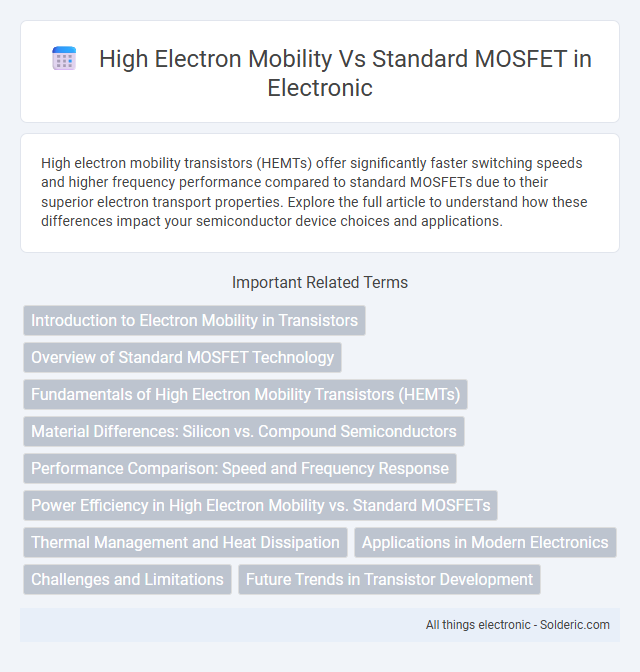High electron mobility transistors (HEMTs) offer significantly faster switching speeds and higher frequency performance compared to standard MOSFETs due to their superior electron transport properties. Explore the full article to understand how these differences impact your semiconductor device choices and applications.
Comparison Table
| Feature | High Electron Mobility Transistor (HEMT) | Standard MOSFET |
|---|---|---|
| Carrier Mobility | High electron mobility; enables faster operation | Lower electron mobility; slower compared to HEMT |
| Material | Compound semiconductors (e.g., GaAs, GaN) | Silicon-based |
| Frequency Response | High-frequency applications (GHz to THz) | Lower frequency range, typically MHz to low GHz |
| Power Efficiency | High power efficiency, suitable for RF and microwave circuits | Moderate power efficiency |
| Gate Structure | Schottky gate or MIS gate | Oxide-semiconductor gate (MOS structure) |
| Operating Voltage | Higher breakdown voltage | Lower breakdown voltage |
| Applications | RF amplifiers, satellite communications, mmWave devices | General-purpose switching, digital ICs, analog circuits |
| Cost | Higher manufacturing cost due to compound materials | Lower cost, mature silicon processing technology |
Introduction to Electron Mobility in Transistors
Electron mobility in transistors defines how quickly electrons can move through the semiconductor material when an electric field is applied, directly impacting the switching speed and overall device performance. High Electron Mobility Transistors (HEMTs) utilize semiconductor heterostructures, such as GaAs/AlGaAs, to create a two-dimensional electron gas with significantly higher mobility compared to Standard MOSFETs, which are typically based on silicon. This enhanced electron mobility results in faster transistor switching, lower power consumption, and improved high-frequency performance.
Overview of Standard MOSFET Technology
Standard MOSFET technology utilizes silicon-based channels with moderate electron mobility, which limits switching speed and power efficiency. These devices rely on thermally grown silicon dioxide as the gate dielectric, enabling stable and reliable transistor operation in integrated circuits. The manufacturing process is mature, cost-effective, and widely adopted, but faces performance constraints in high-frequency and low-power applications compared to high electron mobility transistor technologies.
Fundamentals of High Electron Mobility Transistors (HEMTs)
High Electron Mobility Transistors (HEMTs) utilize a heterojunction between two semiconductor materials with differing bandgaps, typically GaAs/AlGaAs or GaN/AlGaN, creating a two-dimensional electron gas (2DEG) with exceptionally high electron mobility. This 2DEG allows for faster electron transport and higher frequency operation compared to standard MOSFETs, which rely on silicon channels with inherently lower carrier mobility. The heterojunction in HEMTs reduces scattering and enhances carrier velocity, enabling superior performance in high-speed and high-frequency applications such as RF amplifiers and microwave circuits.
Material Differences: Silicon vs. Compound Semiconductors
High electron mobility transistors (HEMTs) utilize compound semiconductors such as gallium arsenide (GaAs) or indium gallium arsenide (InGaAs), offering electron mobility significantly higher than silicon used in standard MOSFETs. This increased mobility results from the superior crystal structure and lower electron effective mass in compound semiconductors, enabling faster switching speeds and better high-frequency performance. Your device's overall speed and efficiency can be greatly enhanced by choosing HEMTs for applications requiring high-frequency and low-noise operation.
Performance Comparison: Speed and Frequency Response
High electron mobility transistors (HEMTs) exhibit significantly faster switching speeds and higher frequency response compared to standard MOSFETs due to enhanced electron velocity and reduced channel resistance. Your applications demanding ultra-high-speed data processing or RF amplification benefit from HEMTs' superior cutoff frequencies, often exceeding tens or hundreds of GHz, far surpassing the typical MOSFET range. While standard MOSFETs remain efficient for general-purpose switching, HEMTs excel in high-frequency environments, providing unmatched performance in speed and frequency domains.
Power Efficiency in High Electron Mobility vs. Standard MOSFETs
High Electron Mobility Transistors (HEMTs) exhibit significantly superior power efficiency compared to standard MOSFETs due to their higher electron mobility, enabling faster switching speeds and lower ON-resistance. This results in reduced power loss and improved thermal performance in high-frequency and high-power applications. Optimizing your circuit with HEMTs can enhance overall energy efficiency, especially in RF and power amplifier designs.
Thermal Management and Heat Dissipation
High electron mobility transistors (HEMTs) exhibit superior thermal conductivity compared to standard MOSFETs, enabling more efficient heat dissipation during high-frequency and high-power operations. The advanced materials used in HEMTs, such as GaN or AlGaN, offer higher thermal stability and lower thermal resistance, which reduces hotspot formation and enhances device reliability. In contrast, standard silicon-based MOSFETs often face challenges in thermal management due to lower thermal conductivity, leading to increased junction temperatures and potential performance degradation under extended stress.
Applications in Modern Electronics
High electron mobility transistors (HEMTs) offer superior speed and frequency performance compared to standard MOSFETs, making them ideal for high-frequency applications such as 5G communication, satellite systems, and radar technology. Standard MOSFETs remain prevalent in digital integrated circuits, power management, and low-frequency analog applications due to their cost-effectiveness and ease of fabrication. For your advanced electronic design, choosing a HEMT can enhance efficiency and signal integrity in high-speed, high-power environments.
Challenges and Limitations
High electron mobility transistors (HEMTs) face challenges such as complex fabrication processes and lattice mismatch issues that can introduce defects, reducing device reliability compared to standard MOSFETs. Standard MOSFETs offer mature manufacturing technology and scalability but suffer from lower electron mobility, limiting high-frequency and high-speed applications. Your choice between HEMT and MOSFET technology depends on balancing performance requirements with fabrication complexity and cost constraints.
Future Trends in Transistor Development
High electron mobility transistors (HEMTs) demonstrate superior speed and efficiency compared to standard MOSFETs due to their higher electron velocity and reduced channel resistance. Future trends in transistor development emphasize integrating HEMT structures with novel materials like gallium nitride (GaN) and indium gallium arsenide (InGaAs) to enhance performance in high-frequency and low-power applications. Advances in scaling and heterostructure engineering are expected to push device capabilities beyond traditional silicon MOSFET limits, enabling breakthroughs in 5G, AI, and quantum computing technologies.
High electron mobility vs Standard MOSFET Infographic

 solderic.com
solderic.com